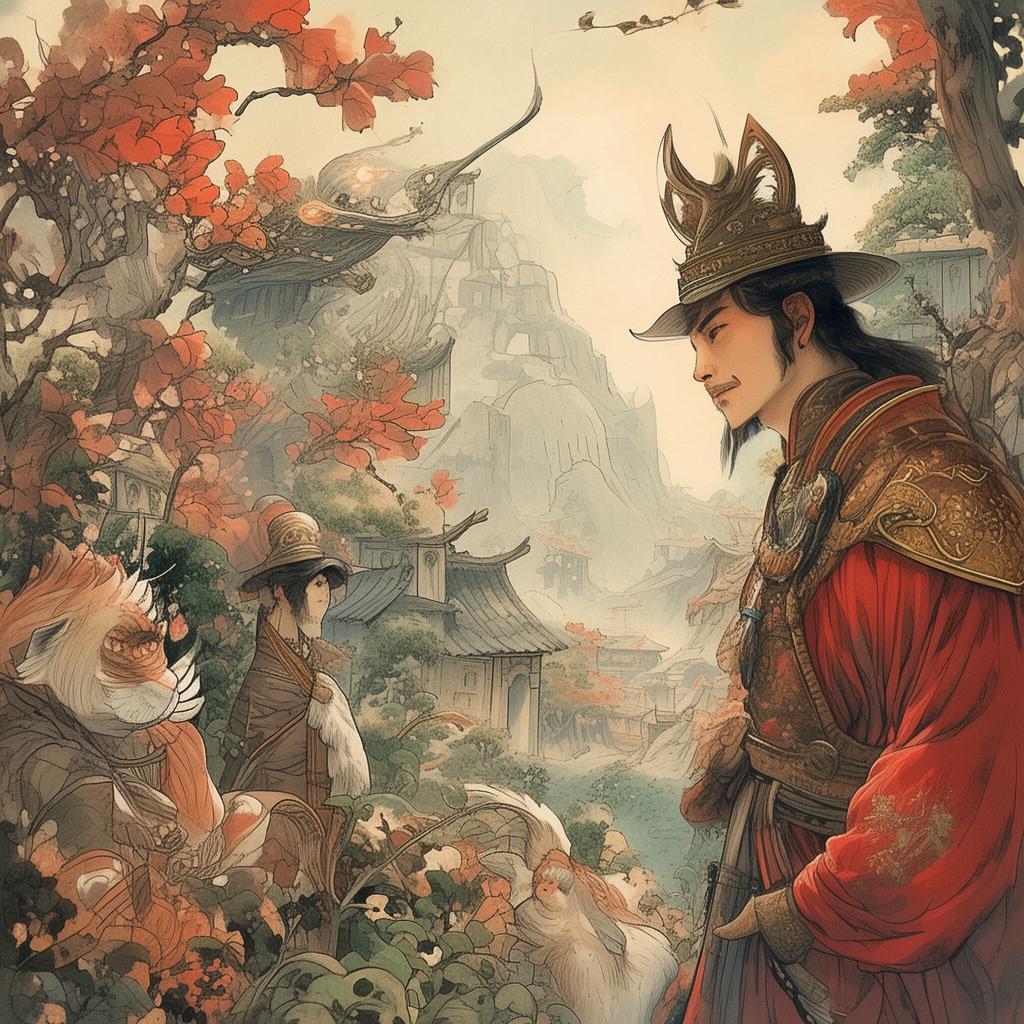The Echoes of Time: The Drummer's Riddle
In the heart of the ancient village of Linglong, where the mountains kissed the clouds and the rivers sang lullabies, there lived a boy named Ming. Ming was not an ordinary child; he was the village drummer, a title that carried more weight than any could imagine. His father, a revered sage, had taught him the art of drumming, a tradition passed down through generations. But the beats that Ming played were not just rhythms; they were ancient incantations, a language of the ancients that spoke of time, space, and the mysteries of the cosmos.
One evening, as the sun dipped below the horizon, casting a golden glow over the village, Ming was practicing his drums. The sound of the drums was as much a part of the village as the mountains and rivers. It was during this practice session that Ming heard a peculiar drumbeat, a rhythm that was not of his making. The beat was hauntingly familiar, yet it seemed to come from a distant land, a time long past.
Curiosity piqued, Ming followed the beat to the edge of the village, where he found an old, weathered drum lying in the grass. The drum was covered in strange symbols, none of which Ming recognized. As he touched the drum, the symbols began to glow, and the beat grew louder, almost overpowering the sound of the mountains and rivers.

A figure emerged from the shadows, an ancient sage with a long beard and eyes that seemed to pierce through time. "You have been chosen," the sage said in a voice that carried the weight of eons. "The Drummer's Riddle is a test of your heart and soul. Only those who can understand the rhythm of time can solve it."
The sage handed Ming a scroll, written in a language that Ming could not decipher. The scroll was filled with symbols and equations, each one a clue to the riddle. Ming knew that this was no ordinary task; it was a journey through time itself, a quest that could change the course of history.
Ming returned to his village, determined to solve the riddle. He spent days and nights poring over the scroll, deciphering the symbols, and practicing the drumbeat. The villagers watched in awe, their lives intertwined with the fate of the young drummer. Some saw him as a savior, while others feared the unknown that lay ahead.
As Ming delved deeper into the riddle, he discovered that the symbols were not just mathematical equations but also a form of time travel. Each symbol represented a moment in time, and the drumbeat was the key to unlocking those moments. Ming realized that to solve the riddle, he had to travel through time, witness events that had not yet occurred, and bring back the knowledge that would change the future.
The first stop on his journey was ancient Egypt, where he witnessed the construction of the Great Pyramid. As he drummed, the symbols on the scroll began to glow, and Ming was transported back to the moment when the first stone was laid. He learned the secrets of the pyramid, the knowledge of the ancients, and the power of the drumbeat.
The next stop was the Renaissance, where Ming observed the birth of the printing press. Again, as he drummed, he traveled back in time, witnessing the first pages being printed. He understood the importance of knowledge and its power to change the world.
The journey continued, taking Ming to different eras, each one filled with its own mysteries and lessons. He saw the rise and fall of civilizations, the discovery of new lands, and the evolution of humanity. Through it all, Ming remained true to his drum, using its rhythm to navigate the currents of time.
Finally, Ming arrived in the future, a time when technology had reached its peak. He saw a world of wonder and destruction, a world that was both a marvel and a cautionary tale. As he drummed, he realized that the riddle was not just about time travel; it was about the balance between progress and preservation.
With the knowledge he had gained, Ming returned to his village, the scroll now empty, the symbols faded. He shared his experiences with the villagers, teaching them the importance of understanding the past to shape the future. The village of Linglong thrived, its people living in harmony with nature, their hearts and minds enriched by the wisdom of time.
Ming's journey was not just a tale of adventure; it was a testament to the power of curiosity, the importance of knowledge, and the rhythm of time that binds us all. The Drummer's Riddle was solved, not just by Ming, but by the village of Linglong, and the echoes of the drumbeat continued to resonate through the ages, a reminder of the timeless connection between humanity and the cosmos.
✨ Original Statement ✨
All articles published on this website (including but not limited to text, images, videos, and other content) are original or authorized for reposting and are protected by relevant laws. Without the explicit written permission of this website, no individual or organization may copy, modify, repost, or use the content for commercial purposes.
If you need to quote or cooperate, please contact this site for authorization. We reserve the right to pursue legal responsibility for any unauthorized use.
Hereby declared.









